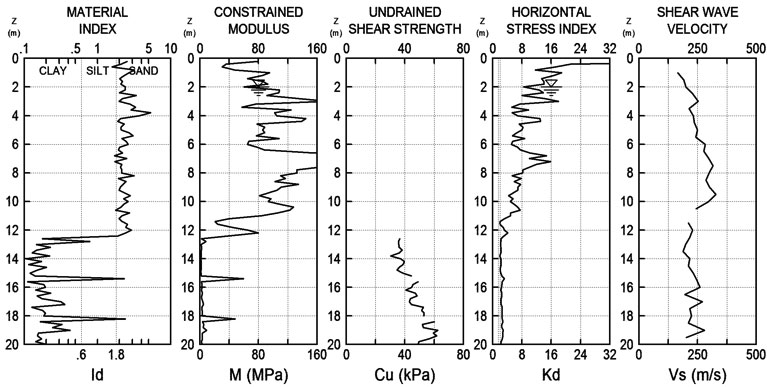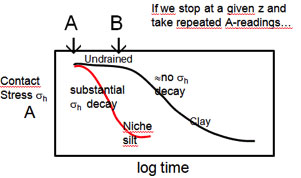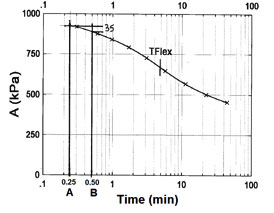The simplest way to find out if the silt is a niche silt or not, is to execute, normally in the middle of the 20 cm depth intervals, some short “A and deflate” dissipations, without expansion from A to B, i.e. without movement of the membrane. An adequate duration of these dissipations is two minutes, hence much shorter than DMTA dissipations where the entire S-shaped curve is obtained. These short dissipations permit to find out if appreciable A reduction occurs during the test. If the A-decay in the initial 0.5 minutes is appreciable, then the soil is a niche-silt, i.e. there is appreciable dissipation during the test. Conversely, if A is relatively constant in the initial 0.5 minutes, then the test is either fully drained or fully undrained. In sands the A-reading is constant because there is no excess pore pressure due to the penetration. In clay the A-reading is constant because the excess pore pressure caused by the penetration has no time to dissipate appreciably during the test. The horizontality of the short DMTA dissipation excludes that the soil is a niche silt. Quantitatively, it can generally be excluded that a silt is a niche silt if, in a short two-minute A-only dissipation, the A reduction in the two minutes is less than 5%. An adequate number of short dissipations in niche silts sites is 10 dissipations in a DMT sounding. If the soil is not a niche silt, then the interpretation can proceed normally, using the common interpretation formulae.
Niche Silts
DMT in partially draining saturated silts ("niche silts")
DMT is executed, in most cases, in sands, silts and clays. In sands (“permeable”) and in clays (“impermeable”) the interpretation is simpler, because the test conditions during the ≈ 0.5 minutes duration of the test, are either fully drained or fully undrained. A specific “niche” of relatively permeable saturated soft silts requires a special DMT interpretation, because, during the test, there is partial drainage. It is important (a) To first recognize if the soil is a niche silt (b) Then, if the soil has been recognized to be a niche silt, to adopt a special interpretation.
If the A and B readings in niche silts are interpreted using the usual DMT formulae, the derived parameters may be in error. Fortunately niche silts are easily recognizable, by short (a couple of minutes) and inexpensive “A-only” dissipation tests, as described in this document. Short dissipations, when the soil is saturated silt, should be systematically executed by operators. Profiles of ID and MDMT as in Fig. 1, should prompt operators to suspect niche silts and to execute short dissipations to confirm/ disconfirm the suspect.
How to determine if the soil is a “niche silt”
Ambiguity arising when ID (often MDMT too) is very low
One consequence of the partial drainage is that B-reading is not the “proper match” of the A-reading, being too low, due to the reduction of the excess pore pressure against the membrane in the time from A to B. Also too low is, in turn, the difference B-A and consequently ID ED MDMT. In general very low ID (say ID =0.1-0.2) and very low MDMT, immediately recognizable when inspecting the graphs of the results, prompt with evidence the suspect of a niche silt. For instance the very low values of ID and MDMT in Fig. 1 prompt with evidence said suspect.
The ambiguity in Fig. 1 is the following. Is ID very low because the soil is a “very clayey” clay or because it is a niche silt? Is MDMT really so low, or its very low value is due to a niche silt soil?
The ambiguity can be easily resolved by executing a short A-only dissipation. If the A decay in the initial 0.5 min is appreciable, then the soil is a niche silt. In this case ID, ED, MDMT calculated using the common formulae are too low (of an unknown quantity) and are not usable as such – unless adequate corrections are applied.

Attempting a correction of the B value
If dissipations have established that the silt is a niche silt, the A-decay dissipation curve has a shape similar to the first curve in Fig. 2a, indicating appreciable decay during the test duration. Note that in both Fig. 2a and Fig. 2b all the points of the curves are A-only readings. The letter B in the figures is used just to indicate the time when B is to be taken (≈ 15 sec after A). From the dissipation curve it is possible to determine the drop of the contact pressure during the inflation from A to B. In this case Drop=35 kPa (Fig. 2b). An approximate correction can then be to add the Drop to all the B-readings in the layer of niche silt under consideration, in order to approximately restore what B would have been in absence of dissipation. Note that Fig. 2b shows a complete dissipation, because an estimate of Ch was in this case also required. But the correction 0.35 would have been possible based only on a short dissipation.

Fig. 2. (a). Dissipation curves in niche silts and in clay (repeated A-only readings)

Fig. 2. (b) Drop of the contact pressure in the approximately 15 sec inflation.
Undrained shear strength Su in niche silts
Since the time to A is typically only 10-15 sec, in many cases the A pressure will be taken in essentially undrained conditions, and possibly reasonable estimates of Su and KD can be obtained, as they depend essentially only on A. This possibility can be verified by executing a short DMTA dissipation. Unless there is a substantial drop of A in the initial 12 sec, the conditions are undrained. If the A drop in the initial 12 sec is substantial, a back extrapolation of the dissipation curve might in some cases permit a reasonable estimate of the A-value in the initial seconds, value that can then be used to derive Su. If the A drop in the initial ≈ 3 sec is substantial, there is no way to estimate Su. Actually it is impossible to find out if the A drop in the initial ≈ 3 sec is substantial. However, if the last part of the curve obtained in a short dissipation has an upward curvature, the test is practically a drained test.
It is noted that the amplitude of the niche is narrower for Su than for other parameters, because the time to A is roughly 50% the time to B. There is no study on the % of silts that are niche silts vs all silts. A guess at this stage may be 10-20%, i.e. most silts do not drain appreciably during a DMT. Only relatively permeable silts are niche silts.
While niche silts represent a small fraction of the existing soils, the niche may have full centrality for example in some tailings or semiliquid slurries or glacial rock flour. As noted above, KD and Su can, in some cases, be determined in niche silts by DMT with some reliability. Therefore in tailings composed of niche silts, undrained stability analysis, based on DMT results, may be possible. However, as noted above, if the A drop in the initial ≈ 3 sec is substantial, there is no way to estimate Su.
Times for reading
While in sand or in clay the DMT results, as confirmed by experience, are not sensitive to time-for-reading changes by a factor of 2 (ASTM D6635-01 Standard Test Method DMT), in saturated niche silts A and B are to some extent sensitive to time-for-reading.
Recalled below are the typically recommended times for reading, counted from time t=0 (t=0 is the time when the blade has reached the test depth):
- Start the inflation immediately after reaching the test depth (in practice say 2 sec): time t ≈ 2 sec
- Time from pressure zero to A: 10-15 sec, hence read A at time t ≈ 12-17 sec
- Time from pressure A to B: 10-15 sec, hence read B at time t ≈ 22-32 sec
Indications that can also be expressed as: the A- reading shall be obtained within ≈15 sec from reaching the test depth and the B- reading within ≈15 sec after A.
Seasoned operators often reduce the testing time by inflating “rapidly” until say 70% of the expected reading (A or B), then slowing to accurately read the pressure. This inflation method minimizes the pressure drop along the cable when it is time to take the reading. In this way the recommended 15 sec may be reduced to say 7 sec. When testing silts a side advantage of this “short” procedure is that there is less time for drainage, and therefore the niche of partially draining silts becomes narrower.
Notes
A first draft of this document is contained in Section 5 of Marchetti (2015) ” Some 2015 Updates to the TC16 DMT Report 2001″, Proc. DMT’15, Rome.
In that section it is noted, among other things: An alternative mode of testing the silts in the niche would be a drained test, by slowing every stage of the test to insure Du = 0 throughout the test, i.e. regarding the silt as a “sand”. The “drained” A,B values could provide interesting additional information. However no sufficient research has been conducted so far in this direction.

